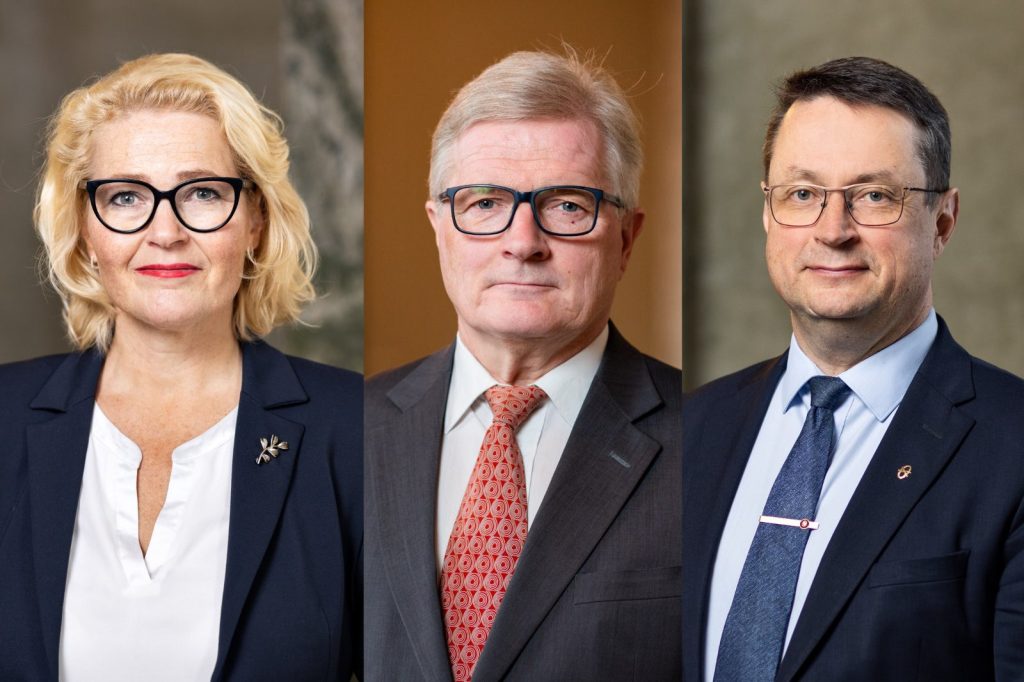Pidin perjantaina 26.11.2021 puheen Pohjoismaiden ministerineuvostossa digitaalisesta osallisuudesta. Voit lukea koko puheen englanniksi alta.
Digital inclusion in the European Union, Nordic council of ministers, speech 26.11.2021
Dear friends, colleagues,
Honourable ministers, audience, friends,
There is much that unites the Nordic and Baltic countries. One very concrete thing is of course the sea. The sea has always been the door to trade and explore. This openness has made us open to explore new ideas and techniques. Something about this adventurousness has transferred to the way we approach digitalization. For a long time, we have been eager to say yes to new technologies and adopt them quite easily. While we are not the biggest players in the globe, this has led to Nordic and Baltic regions becoming one of the pioneering regions for many technical innovations.
However, we are part of the larger whole. In order to truly make a guide in the digital economy, we can also use broader shoulders than just the Nordic ones. Nordic countries are not big enough alone to bring about rules for global technology companies. European Union has economy almost one fifth of the world and population of 450 million. If we want to shape the direction of digital development, this is our level of action when we want to direct our course in the new technological era.
In 2021, we are now in the face of a new technological leap. The abundance of data, applications of AI and internet of things create opportunities we are just starting to identify. Looking back helps to see the pace of change – imagine uploading a digital COVID pass to a mobile phone from 10 years ago. Or imagine explaining to somebody that has been off grid for the past 10 years, what is a Wolt-courier driving by on an electronic scooter with wireless headphones over her ears?
Europe’s dual challenge
On the face of this new transformation we have a dual challenge to solve. On the one hand, we cannot rely on old accomplishments and past victories to take us to the next era of technological development. To stay up to date, we should look forward, to the ways we can best make use of the newest inventions. Someone needs to go first, to innovate and test new inventions.
On the other hand, we must look also backward to see whether everybody stays on-board. When the speed of the technological development increases, the gap between those at the frontline of the new technologies and those might widen. Unfortunately in Europe, those at the back are further than before. These digital gaps exist both between and inside of countries.
First gap is between countries. I am sure many of you are familiar with this first picture. The DESI – index is a common European benchmark for the digitalization of countries, measuring connectivity, human capital, use of internet services, integration of digital technology and digital public service. Especially the Nordic and Baltic innovation in the digital public sector is one of my favourite examples.
This second picture on the right you might not have seen before. Last year the European Statistics authority Eurostat conducted the first survey on the uptake of artificial intelligence in private businesses. While the countries are not the same, we can see the same big picture. In some countries, almost a quarter of businesses have taken up artificial intelligence technologies. In others, the development is only about to start.
Second digital gap is inside the countries. COVID-19 was a good eye-opener on the level of digitalization in the Europe. For some, the shift towards online world happened quite easily. For others, the leap was much more difficult. These gaps are reinforced by other divides in our society. Richer had better access than the poor; urban folks better than rural; and highly educated more than those uneducated. Just as an example, according to UNESCO even in the world’s most developed countries, during the first COVID-19 crisis, access to digital education was around 90 %, with 10 % of school pupils still being left behind. Same gap exists in the digital infrastructure – the access to basic digital resources like a fast connectivity and efficient devices is unequally distributed inside the European community.
Minding these gaps while still staying in the frontline of digital development is one of the big challenges of this decade. When we talk about the innovations of the next generation, we must be wary not to create technology that is only the most commercially profitable or that is enjoyed by those already the most well-off. It is important, that we create technology that benefits both triathlonists in Stockholm as well as sick grandmothers in Vaasa. This is not only a question of nationality or income, but also of disabilities.
This is why I believe majority of our public sector resources should be directed to those who are in the danger of being left out. While markets are very good at delivering digital solutions to those with can pay the most, the public sector is especially needed to help to deliver this transformation those who need these technologies the most. This is not only a question of wealth and nationality. We must make the digital transformation accessible to also those, who live with disabilities.
In European level, bridging these gaps has been put to the centre of attention. In last March, Commission published its vision for the transformation of digital decade. This so called Digital Compass consists of four cardinal points: infrastructure, skills, businesses and public services.
- First, we need secure, performant and sustainable digital infrastructures. The pandemic has shown us how important it is to have reliable network connections
- Second, we need to invest in skills. People should make the most of digital technologies, and fully participate in our increasingly digital world.
- Third, and building on the first two objectives, we must promote the digitalisation of Europe’s businesses. Our ambition for 2030 is to have more world-class European start-ups, and to make sure that millions of smaller companies take up digital solutions
- And fourth, our digital transition will not be complete without the digitalisation of public services. Public services make a huge difference in our daily lives, think of electronic health records, for example.
In my remarks, I will do a deeper dive on the first two (infrastructure and skills). However, I will touch upon the other parts as well.
Let’s start with the infrastructure. Quite simply, if there is no connections for the data to move and servers to process the digital data, it is quite hard to think how there could be digital development in general.
Commission has laid down some tangible targets. For instance, in a previous Broadband Europe plan, there was a target of a network of at least 100 megabits per second (among other things) in all European homes by 2025. In the Digital Compass, this share will be raised 1000 megabits by 2030. All households would be covered by 5G.
In order to facilitate this digital transformation, the investment to the digital sphere should be proactive. We should not be just waiting for the market to emerge will not necessarily take us to these targets. Providing supply boosts the demand for the products, when new applications and services become available. European Union has been generous in enabling this – almost 150 billion euros through RRF was earmarked to investments in digitalization.
Further, in order to truly facilitate the digitalization of whole Europe, we must create incentives and structures that facilitate the investment, also outside the low-hanging fruits of large metropoles where it is the most profitable.
We should be also keep the big picture in mind. The digital infrastructure is also very concrete thing. It is things like underwater cables, data centres and semiconductor chips. We should be facilitating sustainable European supply of key building blocks of the digital economy. One key initiative in this regard is the upcoming European Chips Act of which we will know more of the next year.
Having the structures in place is just the first step. If the use of digital technology is too expensive, it will not benefit European citizens. One solution to this problem is the active and investment, which leads to supply, that will drive down the price for the end-user.
In addition to mere market forces, there are political decisions to be made too. Just to give few examples, in my first term as a parliamentarian, I was the rapporteur for the roaming-legislation. There one of the key questions has been the wholesale prices for data. While the original proposal envisioned wholesale data prices to be 10 € /GB, the European Parliament managed to push the price to a just a fraction of that. This trend will have to continue. Keeping the wholesale prices for data low is essential for the emergence of smart and citizen-friendly digital economy.
Further, we must be vigilant in protecting the competition and innovation and prevent the exorbitant profits resulting from established market positions. Yesterday’s winners do not automatically have a right to claim the podium in the tomorrow’s race as well. This applies to many areas of digital world, be it platform economy, data economy, broadband infrastructure, cloud computing… you name it! Competitive markets is the driver for infrastructure and the broad coverage.
Enforcing this is the work of regulators and politicians – in European level the past year has introduced many key pieces of legislation that aim to keep individual in the centre of the data economy.
To sum:
- we must be proactive in investing to infrastructures fit for the digital age,
- ambitious in making it affordable
- and politically vigilant in enforcing an economy that delivers value for the society as a whole.
Skills
Now that we structures in place, we can talk about how to use digital skills. Here there is also lot of room for improvement. According to Commission, as of now, only 56 % of adults in the European Union have basic digital skills. This is startling baseline to keep in mind.
One key question is the lack of digital skills. According to Commission, 70 % of European companies report the lack of workforce with sufficient digital skills as a key impediment to development. There are initiatives in EU-level to combat this trend. To name just one, I was affiliated with EU CodeWeek, a grassroots initiative that brought computational thinking and coding skills to over 3.4 million participants in more than 80 countries around the world.
Digital skills is broader than training just only the specialist engineers. Like in a restaurant, it is very hard to create a delicious meal if all members are just great at designing ovens. In addition to digital skills, we should also proceed on digital education. When technologies become ever increasing parts of our society, we must also develop necessary skills to understand, use and evaluate these. Empowering people to integrate new technological capabilities to their own work. We should see digital technology as a support for the existing work, not replacement to it. At its best, technology can accelerate our creativity and wit.
Artificial intelligence is one important tool in this regard. Here one inspiring example has been the Elements of AI course organized by the University of Helsinki. This project is now exported even to Africa, with a cooperation with the University of Nairobi in Kenya. It is great example of how to use digital tools themselves to solve digital issues. It helps to spread knowledge in same way Copenhagen and in Mombasa
Of course, at the same time we must stay at the forefront of research on new tools and technologies. Here the key is working together on European level. No country in Europe, nor in the Nordics and Baltics, has the resources to stay at the cutting edge of all sectors of digital development. We should be an archipelago, not just a bunch of disconnected islands. When we think together, invest together and share our resources together, we can punch way above our weight in the digital economy.
I think the Commission’s idea of a “distributed lighthouse” is a step to the right direction. We have already good examples of this approach. For instance, ELLIS network has done great work in pooling the top European AI talent, resulting in globally competitive network of local centres of excellence. Or consider the ELISE-project, built on top of ELLIS that has further developed the strategic research agenda for the European AI excellence. We should truly protect and nurture these initiatives and mechanisms of mutual learning across borders through exchange programs.
We need to also invest together. The key issue is not that Europe does not have money. Under the Digital Europe Programme, we have allocated 2.1 billion to AI between 2021 and 2027. Horizon Europe Programme contributed to 2.7 billion between 2021 and 2027. Further, coordinated plan on AI envisions private and public investments to AI to rise to 20 billion euros annually between 2021 and 2027. Using these funds wisely in the member states is also important step forward.
In addition to money, we need to share our resources together. One such resource is data. This is especially important for artificial intelligence – if algorithms are the engine, data is the fuel. According to one estimate, 80% of this data lies unused. Data Governance Act was the establishment of European data spaces, where the European data could truly be pooled to the benefit all of European research. Making this data flow across the borders seamlessly will lead to truly pan-European data economy, which is an alternative for big digital monopolies. In this new data economy, data from Reykjavik can be used to optimize industrial systems in Oslo, or where the insights on crop yields from Skåne can be used to optimize farmers’ work in Finland.
So to wrap up my ideas in terms of skills, we must be aware of keeping everyone on board, broadening our perspective from digital skills to digital education and work together on an European scale to stay in the cutting edge of technological development.
My vision how Europe can be the driver for digital inclusion can be summarised under two headings. In the side of infrastructure, we must be proactive in investing to infrastructures fit for the digital age, we have to be politically ambitious in making it affordable and politically vigilant in enforcing an economy that delivers value for the society as a whole. On the side of skills, we must keep everyone on board, broaden our perspective from narrow skills to broader education to empower citizens to use digital technologies and work together on a European scale to stay in the cutting edge of technological development.
While this direction is set, the rubber hits the road when we actually do the work. It is easy to lose sight of the overarching goals, when short-term political interests emerge. Europe is different than the other big competitors of ours. We are open society that believes in cooperation more than commands and force. We believe that we should chart our path to a direction we want to go, not just drift anywhere. This means that our model relies on working together and seeing the common interest over small differences of opinion.
We can also export these ideas to the global scale. Through the so-called Brussels effect, the European regulatory ideas of digital economy like human-centricity and consumer-centricity have a possibility to spread to the global arena. Many of my Nordic and Baltic colleagues have been active in defending the European values in the context of the latest large legislative files.
I am sure we all share the same ambition and end goal – an inclusive European digital decade. In 2021, the union institutions start working delivering the governance mechanisms, the Path to the digital decade that make these objectives a reality. I hope the common shared ambition can be translated to action.




